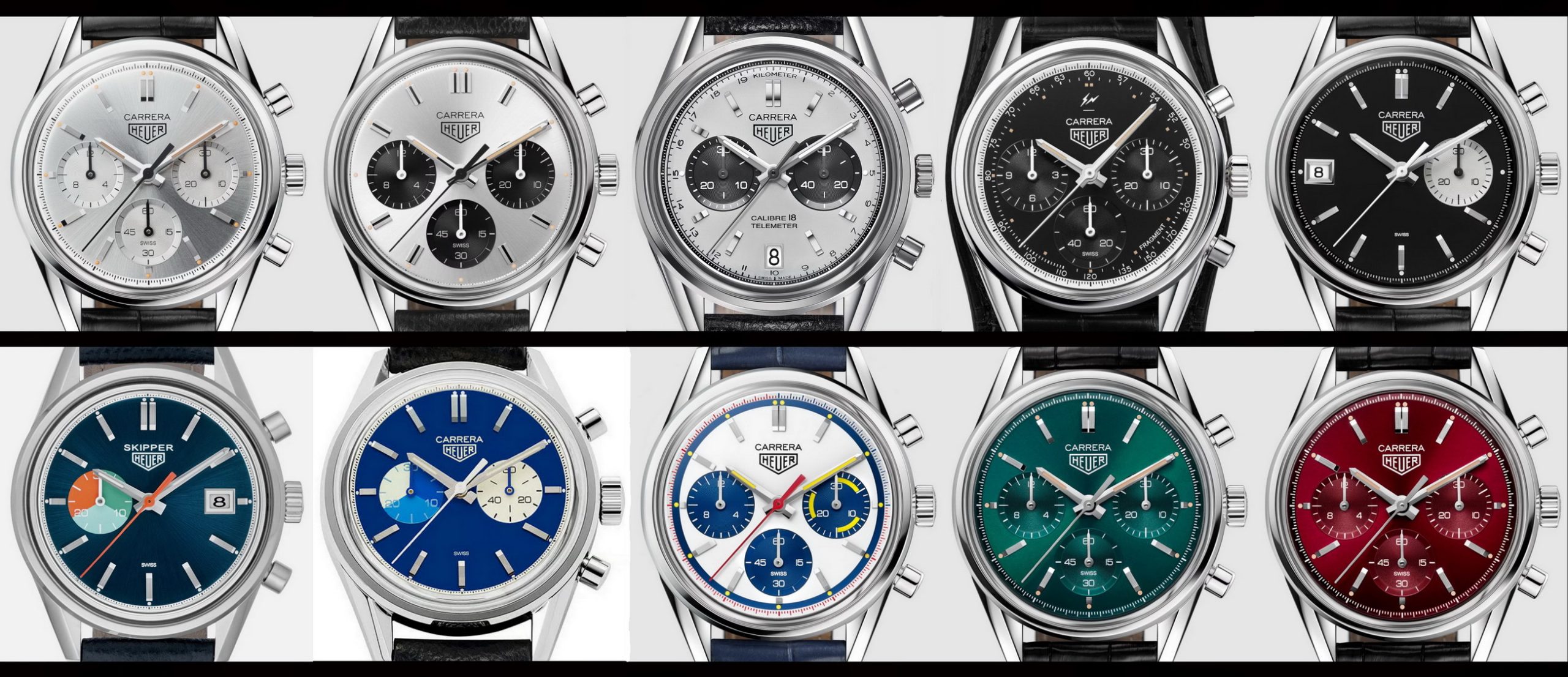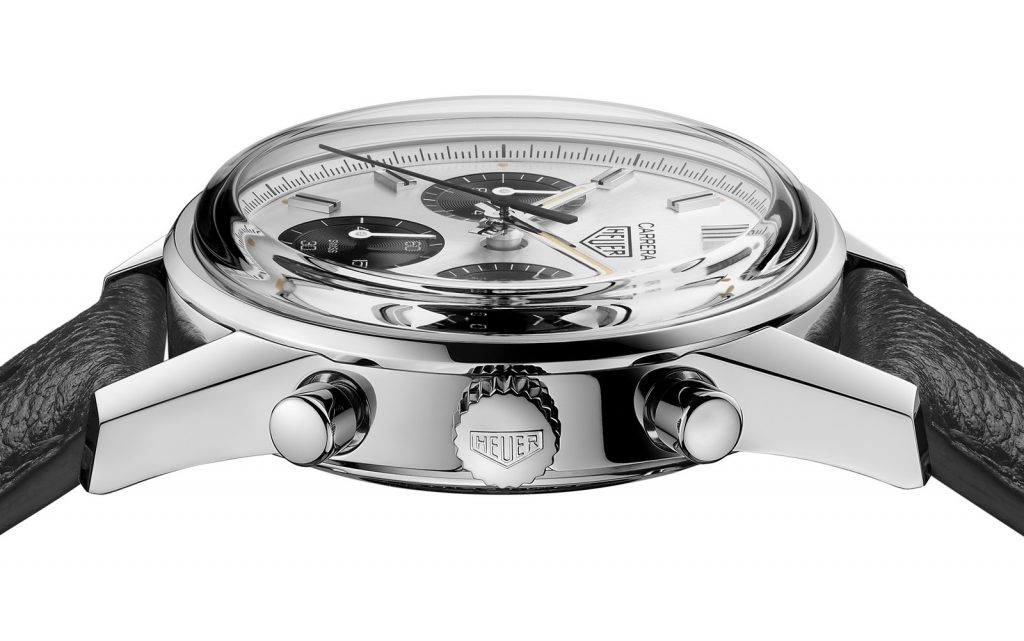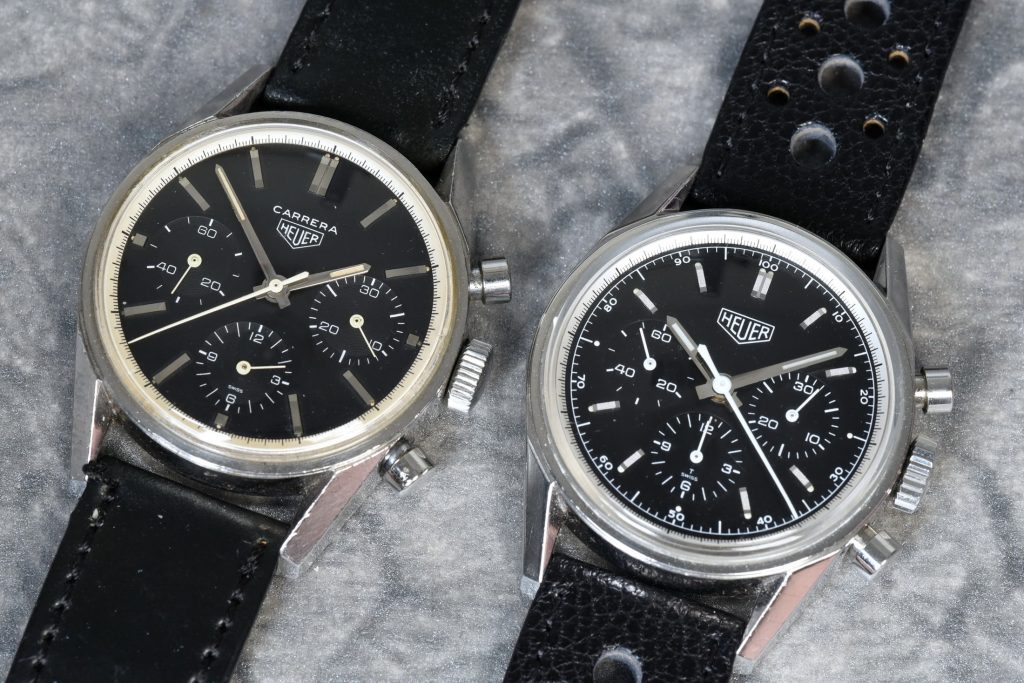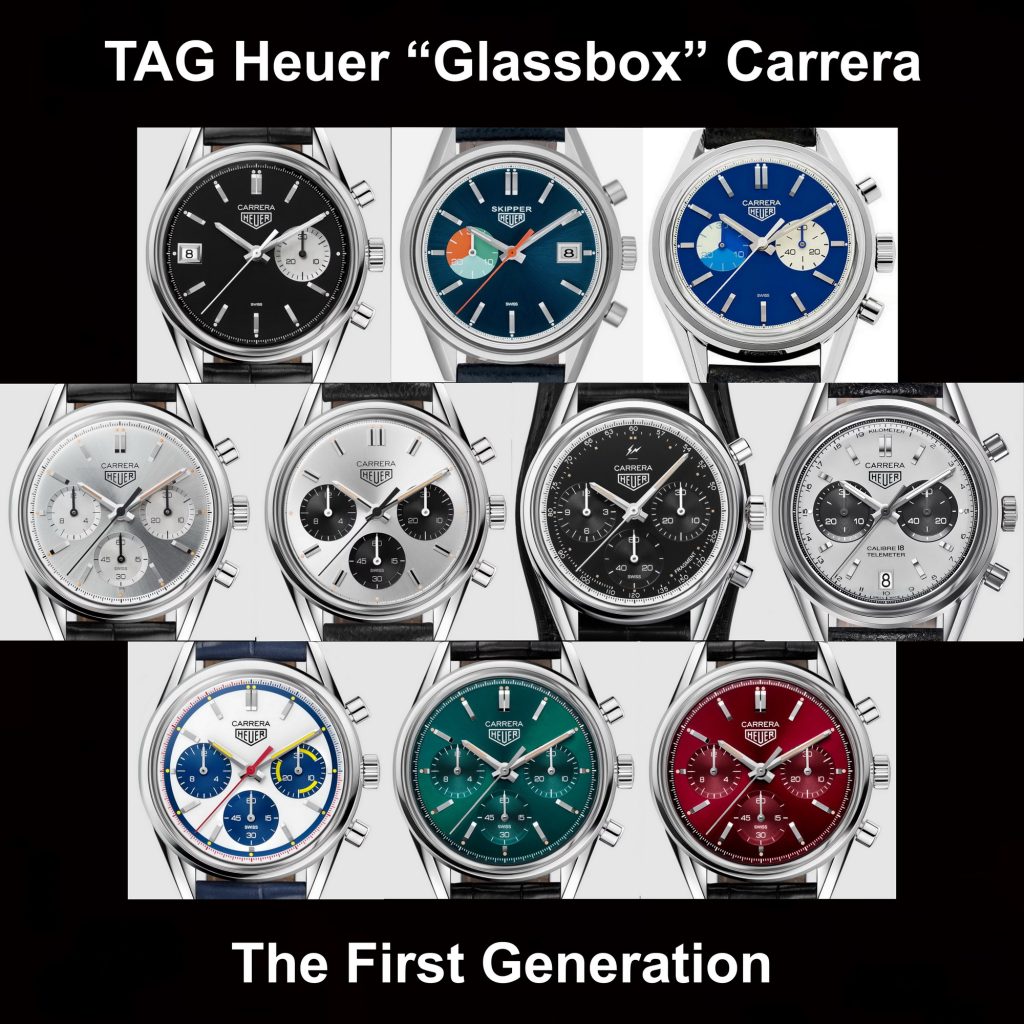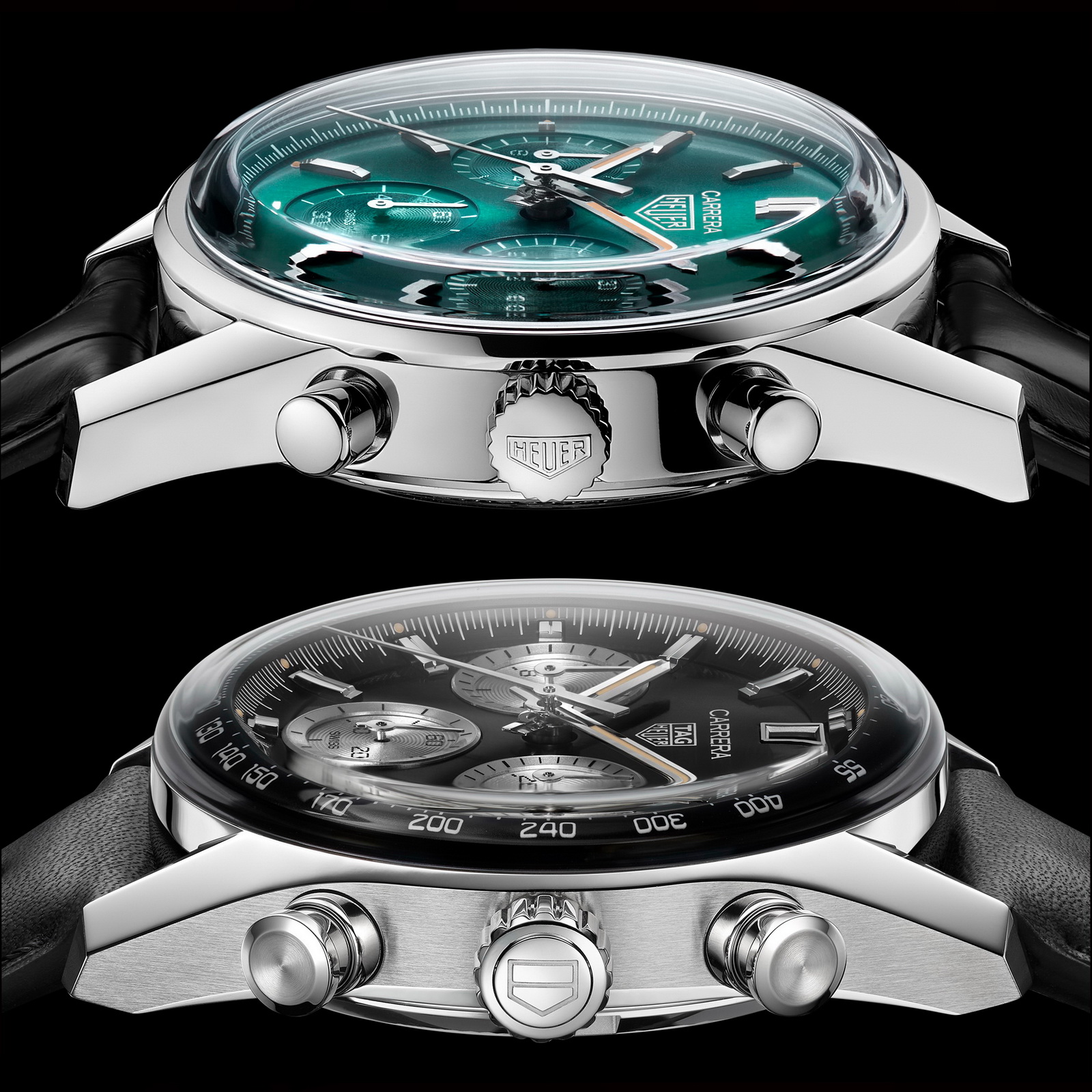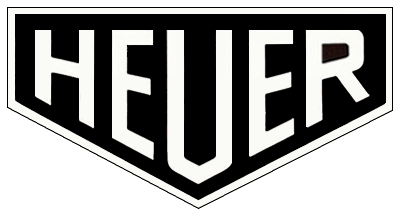Over the period from March 2015 through January 2023, TAG Heuer offered 10 versions of the “Glassbox” Carrera. The first Glassbox Carrera was a “limited production” model; the next nine were all “limited editions”. We will refer to these 10 models as the “First Generation” Glassbox Carreras.
The defining feature of the Glassbox Carrera is its crystal. TAG Heuer designed a new style of domed sapphire crystal with the geometry of the crystal mimicking that of the original plastic crystals used on the Heuer Carrera chronographs in the 1960s. The sapphire is the “glass” and the high dome forms the “box”; together, we get the “Glassbox”.
All the Glassbox Carrera chronographs used this sapphire crystal, on a 39 millimeter stainless steel case. Also consistent with the Carreras of the 1960s, the Glassbox Carreras had a tension ring (flange) between the dial and the crystal, with hashmarks for one quarter second / minute increments.
The 10 “First Generation” Glassbox Carreras
The following is an overview of the 10 Glassbox Carreras that comprised the “first generation” of these chronographs:
March 2015 — Calibre 18 Telemeter (CAR221A) — Limited Production. In retrospect, we can say, “All’s well that ends well,” but launching the new Glassbox version of the Carrera chronograph with the Calibre 18 Telemeter model was a pretty strange move. Racers want a tachymeter scale. Telemeter scales are for artillery, hardly a segment of the market at the top of TAG Heuer’s list. SO this wasn’t the “Panda” that enthusiasts were hoping for, but was an accomplishment for TAG Heuer — developing a new case / crystal combination that would work well with heritage-inspired models. The Calibre 18 Telemeter showed that TAG Heuer could draw good inspiration from its heritage models, while incorporating modern elements. The Calibre 18 movement is TAG Heuer’s version of a Sellita SW300 base with a Dubois-Depraz chronograph-module DD 2223.
See more about this model on Fratello (introduction and retrospective) and on Monochrome.
June 2017 — Skipper by Hodinkee (CAR221B) — 125 Pieces. The Calibre 18 Telemeter didn’t attract much attention while it was in production, but the next version of the Glassbox Carrera solved that problem, being a collaboration with Hodinkee, the leading watch publication on the internet. TAG Heuer produced only 125 of these Skipper chronographs, but the back story was good enough (going back to the original “Skipperrera” from 1968) and the colors were bright enough that the “Glassbox” and the “Skipper” became known to a wide circle of collectors. The crazy colors and somewhat whimsical style of the Skipper seemed to work well in the Glassbox case; the addition of a date window at 3 o’clock evoked the asymmetry of the Carrera 45 Dato (from the mid-1960s). This Skipper was also powered by the Calibre 18 movement.
Read about this chronograph in Hodinkee’s introduction of the watch.
April 2018 — Blue Dreamer by Revolution / The Rake (CAR221C) — 100 Pieces. In designing the Skipper, the Hodinkee team took a favorite model from Heuer’s heritage portfolio, and made some modifications that would make it appealing to a contemporary enthusiast. Wei Koh, founder of watch publication “Revolution” and men’s fashion magazine “The Rake”, explains that his team took an entirely different approach in creating the “Blue Dreamer” Carrera. Rather than starting with a watch from the 1960s, Koh and his colleagues began by visualizing a glamorous personality from that era, fictional but based on those who roamed the Riviera in this period, and then creating the watch that they would enjoy. This imaginary Rake represented the “playboys, adventurers, aristocrats and lovable scoundrels that breathed life into the Riviera” — Gianni Agnelli, Ally Khan, and of course, James Bond, among many others. The watch for this figure had to be blue, with the tone from Yves Klein’s painting “Blue Monochrome” for the dial, and Ultramarine and Sky or Cerulean Blue for the chronograph recorder. The Movement was the Calibre 18.
Wei Koh explains the origins of the “Blue Dreamer” in this very interesting posting in Revolution.
November 2018 — Fragment Design (CBK221A) — 500 Pieces. Once we are engaging Hodinkee and Revolution / The Rake to design watches inspired by Heuer’s 1960s portfolio, why not give the mandate to a leading streetwear designer, Hiroshi Fujiwara of Fragment Design? Fujiwara went back to a rare model from the late 1960s (the Reference 2447 NT), to see what the ultimate racing chronograph might look like. Black dial; black registers; tachymeter scale printed on the dial; the smallest possible lume squares to mark the hours. The Fragment Design Glassbox Carrera marked the first appearance of the Heuer 02 movement in a Glassbox Carrera. In using this movement, TAG Heuer gave vintage enthusiasts the watch they wanted — a dial with a traditional 3-6-9 layout (sometimes called “tri-compax”), with the reliability of a state-of-the-art TAG Heuer movement.
I wrote an introduction to the Fragment Design Carrera on Hodinkee.
January 2020 — 160th Anniversary, Silver (CBK221B) — 1,860 Pieces. With the Fragment Design Carrera having brought the Heuer 02 movement to the Glassbox collection, TAG Heuer now had the ability to pay appropriate tribute to the legendary three-register models from the 1960s (Reference 2447). To mark the 160th anniversary of the Heuer brand (1860 to 2020), TAG Heuer offered two three-register versions of the Carrera. The version with the silver / white starburst dial captured the look of the first Carrera chronographs, from 1963 (Reference 2447S), and instantly became a favorite among collectors.
Read Hodinkee’s “Hands On” review HERE or Monochrome’s review HERE.
January 2020 — 160th Anniversary, Montreal (CBK221C) — 1,000 Pieces. As a companion to the relatively quiet 160th Anniversary Silver limited edition, the “160th Anniversary Montreal” incorporated the style of one of Heuer’s most outrageous chronographs from the 1970s, the Montreal. We see a bright white dial, deep blue for the registers and outer ring, yellow for the racing stripes (on the chronograph minute recorder), more yellow for the lume for the hour markers and in the hands, and bright red for the chronograph second hand and hashmarks on the inner bezel. These strong colors were well-suited for the huge lump of steel that was the 1970s Montreal; incorporating them into the very traditional Carrera case from the 1960s was an exercise in juxtaposition.
This model of the Carrera is covered on Hodinkee and Monochrome.
February 2021 — Hodinkee “Dato” Carrera (CBK221D) — 250 watches. Heuer first offered the “45 Dato” in 1966, but it was the second execution with the black dial from 1968 that became the collectors’ favorite. This Carrera featured a date window at 9 o’clock and a single white register for chronograph minutes at 3 o’clock, giving the watch an asymmetrical “cyclops” look. Hodinkee didn’t stray far from the original, except that the minute recorder now has a capacity of 30 minutes (rather than 45 minutes), with the hour recorder of the Heuer 02 movement being deleted.
Here is the introduction on Hodinkee.
May 2021 — Teal Dial (CBK221F) — 500 Pieces. The color schemes of the first seven versions of the Glassbox Carrera chronographs had stayed within the four corners of the Heuer heritage portfolio — silver / white, black and blue (for the Skipper). With the use of a teal dial for the eight model, TAG Heuer showed that the Glassbox Carrera could move beyond this historic portfolio, to incorporate colors that are enjoying current popularity.
Gear Patrol offered its review of this model.
July 2022 — Red Dial (CBKTBD) — 600 Pieces. Once you make the teal model, you might as well go all the way with the deep red Glassbox Carrera. TAG Heuer had previously used this deep red to capture the passion of racing (for example, in one of the Monaco chronographs that it issued in 2019), making it a natural for the Carrera.
See our introduction and album OnTheDash.
January 2023 — 60th Anniversary “Panda” — 600 Pieces. Many collectors would suggest that TAG Heuer saved the best for the last, marking the 60th anniversary of the Carrera with a homage to one of the “grails” of the vintage universe, the Reference 2447 SN “Panda”. This original “Panda” version of the Carrera dates from 1968, when Heuer introduced contrasting dials (Panda and reverse Panda), and also an update of the dials and hands of the three-register Carrera. This Glassbox Carrera comes close to being a one-to-one copy of the original model, the easiest telltales of the new 60th Anniversary Carrera being the darker registers and the style of the “Swiss” printed at the bottom of the dial, along with the Glassbox crystal, of course.
See our OnTheDash posting for dozens of photos showing the 60th Anniversary “Panda” Carrera and its heritage predecessors.
Putting the First Generation into Perspective
Heuer produced the first generation of Carrera chronographs from 1963 until 1969, at which time the automatic models in their C-Shape cases took over the Carrera catalog. After a decade with no Carreras, in 1996, TAG Heuer created the first re-issues of the Carrera, with near one-to-one copies of some of the original models from the 1960s, with their round cases and unique angular lugs.
From this first re-issue in 1996 through 2023, TAG Heuer has offered almost 400 different versions of the Carrera chronograph, but it was only with the 10 Glassbox Carrera chronographs, spread over the period from 2015 through 2023, that we saw a sustained initiative to capture the best versions of the original vintage models. These 10 Glassbox chronographs covered a wide variety of models, from the near identical copies of the 1960s models (Reference 2447 S and 2447 SN) to the whimsical and “what if?” approaches of the Blue Dreamer and Montreal models. Looking at the 10 models as a group, we see three basic categories — the black and white; the “Datos” and their derivatives (Skipper and Blue Dreamer); and the colorful ones, Montreal, Teal and Red.
All 10 of the First Generation Glassbox models were limited editions, with production runs ranging from 100 samples up to 1,860 samples. In total, approximately 6,000 chronographs were offered, over the eight years of this First Generation. Considered together, these first 10 Glassbox models established that a 39 millimeter case, with a domed sapphire crystal, and TAG Heuer’s Heuer 02 movement would provide an excellent platform to pay tribute to the best of Heuer’s heritage models, along with some more daring, outside-the-box models. Most of the First Generation Glassbox models sold out quickly and continue to sell at a premium, above their list prices.
In March 2023, TAG Heuer launched the “Second Generation” of the Glassbox Carrera. As shown below, the Second Generation Glassbox Carrera differs significantly from the First Generation, primarily in the construction of its crystal. Both cases are 39 millimeters across the dial, but in the Second Generation models, there is no bezel, so the crystal is “stretched” to reach all the way across the dial and down to the mid-case. This gives the new Carrera an entirely different look from the First Generation, which has a traditional bezel atop the mid-case, with the crystal covering less territory.
In only 10 months, TAG Heuer has introduced a total of nine models of the Second Generation Glassbox Carrera — five of them in a 39 millimeter case and and four of them in a 42 millimeter case. It is significant that other than two of the 42 millimeter models offered in a collaboration with Porsche, all these Glassbox Carrera models are not limited edition watches. They will be included in the TAG Heuer catalog and available broadly, meaning that you won’t have to be an “insider” or pay a premium above the retail price to acquire these watches.
Perhaps we should think of the first generation Glassbox Carreras as an intermittent “research and development” project, during which TAG Heuer considered exactly what this collection of watches should be. The 39 millimeter case proved to be popular; colors and complications could be derived from the “classics” of Heuer’s vintage portfolio or created for imaginary characters of the past or future; most importantly, the crystal would be the lens through which all this would be viewed. With this, the first generation of Glassbox Carrera chronographs has paved the way for the second generation, and over the past year TAG Heuer has been rolling out these new Carreras with speed and confidence.
With this, I believe that we can say “mission accomplished” for the First Generation TAG Heuer Glassbox Carrera chronographs. In our next posting, we will begin to take a closer look at the Second Generation Glassbox Carrera, starting with the very distinctive “glass” that covers the “box.”
Jeff Stein
February 5, 2024
